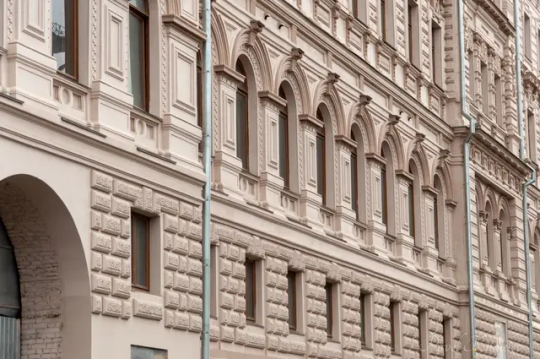#Alexandrovsky Passage
Explore tagged Tumblr posts
Text






















Александровский пассаж – это изумительный архитектурный памятник построенный в духе модерна и барокко. Архитектором великого творения стал Генрих Руш.
В конце 19-го века один из богатейших казанских купцов Александр Александров решился на возведение грандиозного по тем временам торгового здания. Строительные работы шли на протяжении 4 лет и обошлись в баснословную по тем временам сумму – 800 тысяч рублей! В 1883 году глазам казанцев предстало уникальное строение, в честь своего основателя получившее название Александровский пассаж. Особенно выделялось стеклянное покрытие внутреннего двора, которое должно было покорить казанских жителей. Так же в здании было свое воздушное отопление и лифт, который в те времена были в диковинку.
Главный вход (на ул. Кремлёвскую) акцентирован на высоту 2 этажей портиком с двумя скульптурными фигурами кариатид. Фасады оформлены эклектичным архитектурным декором с преобладанием барочно-ренессансных элементов. Главный купол фасада украшен часами, спроектироваными выдающимся мастером Йоханом Войле. Башенные часы исправно работали до самой смерти Александрова и за это время останавливались только 2 раза – в день женитьбы и в день рождения дочери купца. После того, как сердце основателя пассажа перестало биться, стрелки часов замерли на одном месте и с тех пор никто не может запустить механизм Интерьеры здания украшены фигурами людей, изображениями масок лиц, лепными украшениями. Элементы декора, которые использовались при внешнем оформлении здания, неоднократно дублируются. Большинство принадлежит к масонским символам, так как главный архитектор пассажа Генрих Руш был членом этого тайного ордена. Лишь один из них не повторяется – так называемые «зубастые рыбки», которые находятся неподалеку от парадного входа.В середине центрального здания находится светильник — бронзовая статуя женщины, держащей за руку младенца.
После смерти Александрова его сестра передала пассаж Казани и попросила городские власти обустроить в нем публичный музей. Однако для городского музея здание оказалось непригодным и здесь разместили меблированные комнаты и магазины. К концу советского периода здание оказалось в состоянии, близком к аварийному. В 1977 году произошло сильное обрушение, из-за ослабевших грунтов произошло проседание его северного угла. Около 30 лет здание было закрыто на реконструкцию. С тех пор здание Пассажа постоянно покупают и продают, но какие-то ощутимые работы судя по всему внутри так и не ведутся.
The Aleksandrovsky Passage is an amazing architectural monument built in the spirit of Art Nouveau and Baroque. The architect of this great creation was Genrikh Rush.
At the end of the 19th century, one of the richest Kazan merchants, Aleksandr Aleksandrov, decided to build a grandiose commercial building at that time. The construction work lasted for 4 years and cost a fabulous sum at that time - 800 thousand rubles! In 1883, the eyes of Kazan residents appeared on a unique building, named Aleksandrovsky Passage in honor of its founder. The glass covering of the inner courtyard, which was supposed to conquer the Kazan residents, stood out especially. The building also had its own air heating and an elevator, which were a novelty at that time.
The main entrance (on Kremlevskaya Street) is accentuated by a portico with two sculptural figures of caryatids at a height of 2 floors. The facades are decorated with eclectic architectural decor with a predominance of Baroque and Renaissance elements. The main dome of the facade is decorated with a clock designed by the outstanding master Johan Voyle. The tower clock worked properly until Alexandrov's death and during this time it stopped only 2 times - on his wedding day and on the birthday of the merchant's daughter. After the heart of the founder of the passage stopped beating, the clock hands froze in one place and since then no one has been able to start the mechanism. The interiors of the building are decorated with figures of people, images of face masks, stucco decorations. The decorative elements that were used in the exterior design of the building are repeatedly duplicated. Most of them belong to Masonic symbols, since the main architect of the passage, Heinrich Rusch, was a member of this secret order. Only one of them is not repeated - the so-called "toothy fish", which are located near the main entrance. In the middle of the central building there is a lamp - a bronze statue of a woman holding a baby's hand. After Aleksandrov's death, his sister gave the Passage to Kazan and asked the city authorities to set up a public museum in it. However, the building turned out to be unsuitable for a city museum and furnished rooms and shops were placed there. By the end of the Soviet period, the building was in a state close to emergency. In 1977, a strong collapse occurred, due to weakened soils, its northern corner subsided. The building was closed for reconstruction for about 30 years. Since then, the Passage building has been constantly bought and sold, but apparently no significant work has been done inside.
Источник:/chemodan-tour.ru/obzor/aleksandrovskij-passazh/, /m.realnoevremya.ru/articles/92785-aleksandrovskiy-passazh-kazani-istoriya, //yandex.ru/maps/org/aleksandrovskiy _ passazh/ 2802651 98 59/?ll=49.115416%2C55.794060&z=15,/tur-kazan.ru/sights / aleksandrovskiy-passazh /pikabu.ru/story/ aleksandrovskiy_passazh _roskosh_pokryitaya_pyilyu_11501183,www.tripadvisor.ru/Attraction_Review-g298520-d8458290-Reviews-Aleksandrovskiy_Passazh-Kazan_Republic_of_Tatarstan_Volga_District.html, /dzen.ru/a/ZNFuPc30f2oGYXbH.
#Россия#Казань#история#архитектура#Александровский пассаж#Генрих Руш#Ренессанс#Необарокко#Модерн#заброшенные места#Заброшенное#фотография#Russia#Kazan#history#Architecture#Alexandrovsky Passage#Modern#Renaissance#Neo-Baroque#Heinrich Rusch#abandoned#abandoned photography#abandonedplaces#abandonedbuilding#lost in time
182 notes
·
View notes